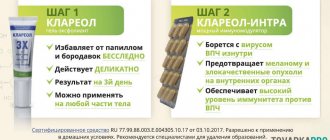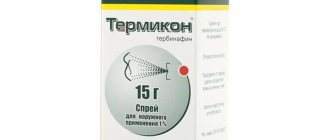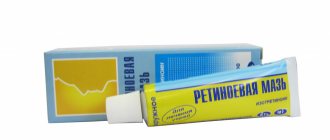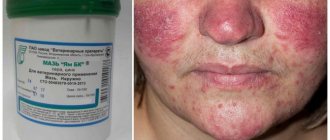pharmachologic effect
An antifungal drug for external use with a wide spectrum of antifungal activity. In small concentrations, terbinafine has a fungicidal effect against dermatophytes (Trychophyton rubrum, Trychophyton mentagrophytes, Trychophyton verrucosum, Trychophyton violaceum, Trychophyton tonsurans, Microsporum canis, Epidermophyton floccosum), yeast fungi (mainly Candida albicans) and certain dimorphic fungi (Pityrosporum orbiculare).
Activity against yeast-like fungi, depending on their type, can be fungicidal or fungistatic.
Terbinafine does not affect the metabolism of hormones or other drugs.
The minimum inhibitory concentration for Trychophyton rubrum is 0.001-0.06 μg/ml. For onychomycosis of the hands, the effectiveness of treatment is 95%, for onychomycosis of the feet - more than 90%. With chronic dermatophytosis of smooth skin, remission is achieved in 75-95% of patients. Subjective improvement in the treatment of progressive candidiasis of smooth skin and lesions of large and interdigital folds, paronychia, caused by Candida albicans and resistant to therapy with nystatin, levorin in combination with clotrimazole and miconazole, occurs within 3-4 days, and complete resolution of the process occurs after 3-5 weeks
Composition of Terbinafine ointment
The main component is terbinafine hydrochloride. In one tube it is contained in the amount of 1g per 100g of composition. As additional substances, it contains rare cross-linked polyacrylic acid in the amount of 1.5 g, as well as 10 g of propylene glycol, 5 g of petroleum jelly, 0.4 g of sodium hydroxide. A large share of the volume is purified water - here it is 81g.
Terbinafine is available both as an ointment and as a gel or cream. The product for topical use is packaged in aluminum tubes, which are placed in cardboard packages, 1 piece each.
Contraindications
Hypersensitivity to terbinafine or to any of the inactive ingredients included in the drug.
Carefully
Renal/liver failure, alcoholism, suppression of bone marrow hematopoiesis, tumors, metabolic diseases, occlusive vascular diseases of the extremities, pregnancy, breastfeeding, children under 12 years of age (lack of sufficient clinical experience of use).
Use during pregnancy and breastfeeding
In experimental studies, teratogenic properties of terbinafine were not identified. To date, no malformations have been reported with the use of Terbinafine cream. However, since clinical experience with the use of Terbinafine cream in pregnant women is very limited, it should be used only for strict indications.
Terbinafine is excreted in breast milk. However, if a nursing mother uses Terbinafine cream, a small amount of the active substance is absorbed through the skin, so adverse effects on the baby are unlikely.
The cream should not be applied to the mammary glands during breastfeeding.
During pregnancy and breastfeeding, use only if the expected benefit to the mother outweighs the potential risk to the fetus or child.
Terbinafine ointment
Registration number: R No. LSR-008761/09
Trade name of the drug: Terbinafine-MFF.
International nonproprietary name: Terbinafine.
Dosage form: Ointment for external use.
Composition per 100 g of ointment: Active substance:
- Terbinafine hydrochloride - 1.00 g
- Excipients: - up to 100 g
- Methyl parahydroxybenzoate (methylparaben) - 0.10 g
- Carbomer (rarely cross-linked polyacrylic acid mAPS-06) - 1.50 g
- Polysorbate - 80 (Tween - 80) - 1.00 g
- Vaseline oil - 5.00 g
- Propylene glycol - 10.00 g
- Sodium hydroxide (sodium hydroxide) - 0.40 g
- Purified water - 81.00 g
Description: White ointment with a characteristic odor.
Pharmacotherapeutic group: Antifungal agent.
ATX code: D01AE15
Pharmacological properties: Antifungal drug for topical use with a wide spectrum of antifungal activity. In small concentrations, terbinafine has a fungicidal effect against dermatophytes (Trichophyton rubrum, T.mentagrophytes, T.verrucosum, T.violaceum, T.tonsurans, Microsporum canis, Epidermophyton floccosum), molds (mainly Candida albicans and certain dimorphic fungi (Pityrosporum orbiculare Activity against yeast fungi, depending on their type, can be fungicidal or fungistatic. Terbinafine specifically changes the early stage of sterol biosynthesis occurring in fungi. This leads to ergosterol deficiency and intracellular accumulation of squalene, which causes fungal cell death. Terbinafine acts by inhibiting the enzyme squalene epoxidase located on the cell membrane of the fungus.Terbinafine does not affect the cytochrome P450 system in humans and, accordingly, the metabolism of hormones or other drugs.
Pharmacokinetics: When applied topically, absorption is less than 5% and has a slight systemic effect.
Indications for use: Prevention and treatment of fungal skin infections, including mycoses of the feet (“fungus” of the foot), inguinal athlete’s foot (tinea cruris), fungal infections of the smooth skin of the body (tinea corporis), caused by dermatophytes such as Trichophyton (including , T.rubrum, T.mentagrophytes, T.verruco-sum, T.violaceum), Microsporum canis and Epidermophyton floccosum. Yeast infections of the skin, mainly those caused by the Candida genus (eg, Candida albicans), particularly diaper rash. Versicolor (Pityriasis versicolor), caused by Pityrosporum orbiculare (also known as Malassezia furfur).
Contraindications: Hypersensitivity to terbinafine or to any of the inactive ingredients included in the drug. Chronic or active liver diseases, chronic renal failure (creatinine clearance 50 ml/min), children under 12 years of age (lack of sufficient clinical experience).
With caution: Hepatic and/or renal failure, alcoholism, suppression of bone marrow hematopoiesis, tumors, metabolic diseases, occlusive vascular diseases of the extremities.
Pregnancy and lactation: In experimental studies, teratogenic properties of terbinafine were not identified. The use of the drug during pregnancy is possible in cases where the expected benefit to the mother outweighs the possible risk to the fetus. Terbinafine is excreted in breast milk. If it is necessary to use the drug during lactation, the issue of stopping breastfeeding should be decided.
Directions for use and dosage: Externally. Adults and children over 12 years of age: Before applying the ointment, clean and dry the affected areas. The ointment is applied once or twice a day in a thin layer to the affected skin and surrounding areas and rubbed in lightly. For infections accompanied by diaper rash (under the mammary glands, in the spaces between the fingers, between the buttocks, in the groin area), the places where the ointment is applied can be covered with gauze, especially at night.
Average duration of treatment:
- Dermatomycosis of the trunk, legs: 1 week 1 time per day
- Ringworm of the feet: 1 week 1 time per day Candidiasis of the skin: 1-2 weeks 1 or 2 times per day
- Tinea versicolor: 2 weeks 1 or 2 times a day.
A decrease in the severity of clinical manifestations is usually observed in the first days of treatment. If treatment is not regular or is stopped prematurely, there is a risk of the infection returning. If after one to two weeks of treatment there are no signs of improvement, the diagnosis should be verified.
The dosage regimen for terbinafine ointment in the elderly does not differ from that described above.
Use of the drug in children: The use of this drug in children under 12 years of age is not recommended.
Side effects: Redness, itching or burning sensation may appear at the sites where the drug is applied. Allergic reactions.
Overdose: No cases of drug overdose have been reported. If terbinafine ointment is accidentally taken orally, you can expect the same side effects to develop as with an overdose of terbinafine tablets (headache, nausea, epigastric pain and dizziness).
Treatment: Activated carbon, if necessary, symptomatic maintenance therapy.
Interactions: There are no known drug interactions for terbinafine ointment.
Special instructions: A decrease in the severity of clinical manifestations is usually observed in the first days of treatment. In case of irregular treatment or its premature termination, there is a risk of recurrence of infection. Terbinafine ointment is for external use only. Avoid contact with eyes as it may cause irritation. If the drug accidentally gets into your eyes, they should be immediately rinsed with running water, and if persistent irritation develops, you should consult a doctor. If allergic reactions develop, the drug must be discontinued.
Release form: Ointment for external use 1%. 10 g or 15 g in aluminum tubes with bouchons made of polymer materials. The tube with instructions for use is packed in a cardboard box.
Shelf life: 2 years. Do not use after expiration date.
Storage conditions: Store at a temperature not exceeding + 25°C. Keep out of the reach of children.
Conditions for dispensing from pharmacies: Without a doctor's prescription.
special instructions
Irregular use or early termination of treatment increases the risk of relapse. If after 2 weeks of treatment there is no improvement in the condition, it is necessary to re-determine the causative agent of the disease and its sensitivity to the drug. During the treatment process, it is necessary to follow general hygiene rules to prevent reinfection (through underwear, shoes). Avoid contact with the mucous membrane of the eyes, nose, and mouth.
Impact on the ability to drive vehicles and operate machinery
During the period of treatment with the drug, it is possible to drive vehicles and engage in other potentially hazardous activities that require increased concentration and speed of psychomotor reactions.
Pharmacokinetics and pharmacodynamics
When taking the medicine orally, the active substance is rapidly absorbed from the digestive tract. Its partial metabolism occurs in the liver, as a result, its bioavailability decreases to 40%. The bioavailability of the drug is only slightly affected by food intake, so there is no need to adjust the dose.
The highest concentration of the drug in the blood is observed 2 hours after the 250 mg tablet was taken. 99% of the active substance in the blood binds to plasma proteins.
The drug is noted to be onycho- and epidermotropic, that is, its largest amount (concentrations optimal for a therapeutic effect) accumulates in the hair, skin, nails, and also in the subcutaneous tissue.
In the body, terbinafine hydrochloride is biotransformed into metabolites that do not demonstrate antifungal activity. Most of them are excreted in the urine. The half-life is 17 hours.
There is no accumulation of Terbinafine when taken. Its effectiveness is the same for all patients, regardless of the person’s age. In the presence of pathological changes in the liver and kidneys, the biotransformation of the drug may slow down. As a result, its concentration in biological fluids increases and the period of circulation of the drug in the blood increases.
When using Terbinafine topically, no more than 5% of the active component enters the blood.
Directions for use and doses
Externally.
Adults and children over 12 years of age: apply the cream to the affected skin and adjacent areas in a thin layer, lightly rubbing, 1 or 2 times a day. The duration of treatment depends on the indication and severity of the disease. The course of treatment is on average 2-4 weeks. Duration and frequency of use: dermatomycosis of the trunk, legs, feet - 1 time per day for 1 week; skin candidiasis - 1-2 times a day for 1-2 weeks; lichen versicolor - 1-2 times a day for 2 weeks.
Indications for use of Terbinafine
The main indication for prescribing Terbinafine ointment is damage to the skin by a fungal infection. First of all, these are mycoses of the skin of the foot. In addition to fungus on the legs, the remedy treats fungal infections of the groin area, which experts call tinea cruris. In addition, smooth areas of the body infected with fungus can also be treated with ointment.
Diaper rash, in the absence of timely and adequate skin care, can become a breeding ground for the proliferation of pathogenic microorganisms. Fungi of the genus Candida especially love this humid environment. This is a yeast type that quickly spreads in folds, on the crooks of the arms and fingers, as well as on hairy areas of the body (head, armpits, groin). Treatment with Terbinafine ointment makes it possible to get rid of this pathogen.
Signs of lichen versicolor are also a reason to prescribe Terbinafine. Mycosis is a common skin disease that affects not only adults, but also children. The first signs of the spread of a fungal infection are the following markers:
- Redness on the skin, usually with clearly defined boundaries of the source of infection. The borders may be uneven and irregular in shape.
- The edges of the lesion often have a whitish tint, especially for lesions of fungi of the genus Candida.
- The inflamed area is itchy.
- The surface of the skin of the affected area peels off.
- At the site of inflammation, vesicles with serous contents appear. Violation of the surface of the bubbles leads to the separation of liquid and the formation of crusts.
Fungal infections are transmitted by contact and airborne droplets. In addition, failure to comply with hygiene standards provokes the spread of mycoses. Therefore, when visiting baths, saunas, public showers and other public places with high humidity, it is necessary to avoid contact of bare feet with the floor.
Mycosis can also appear as a result of wearing low-quality shoes made from non-breathable materials. It is also not recommended to wear synthetic socks in closed shoes.
Terbinafine price, where to buy
The price of Terbinafine in tablets is from 210 rubles for 10 pieces. Terbinafine Teva tablets can be bought for an average of 130 rubles. (pack of 7 pcs.). The average price of Terbinafine cream is 80 rubles. per pack 15 g. The price of Terbinafine spray is from 300 rubles. for 30 ml.
Price of Terbinafine ointment in UAH. (Ukraine) – from 100 UAH. You can purchase the product in Dnepropetrovsk and other cities by order.
- Online pharmacies in RussiaRussia
- Online pharmacies in UkraineUkraine
ZdravCity
- Terbinafine Canon tablets 250 mg 10 pcs. JSC Canonpharma Production
150 rub. order - Terbinafine cream 1% 15g VertexVertex AO
147 RUR order
- Terbinafine tablets 250 mg 14 pcs. JSC Canonpharma Production
RUB 271 order
- Terbinafine cream 1% 30gVertex AO
260 rub. order
- Terbinafine tablets 250 mg 14 pcs. JSC Medisorb
RUB 209 order
Pharmacy Dialogue
- Terbinafine tablets 250 mg No. 10Vertex
RUB 315 order
- Terbinafine-Teva (250 mg tablet No. 28) Teva
RUR 713 order
- Terbinafine (cream 15g)Vertex
50 rub. order
- Terbinafine-Teva (250 mg tablet No. 28) Teva
RUR 702 order
- Terbinafine (cream 30g)Vertex
RUB 233 order
show more
Pharmacy24
- Terbinafine-KV 250 mg No. 14 tablets PAT "Kiev Vitamin Plant", Kiev, Ukraine
80 UAH. order
Analogs
Level 4 ATX code matches:
Atifin
Binafin
Lamican
Griseofulvin
Analogues in tablets are the drugs Lamican , Onychon , Terbizil , Binafin , Exifin , Myconorm , Terbinafine hydrochloride , etc.
Analogues of Terbinafine for external use are the drugs Termicon , Lamisil Uno , Terbinox , Terbizil , Mikonorm , Lamitel , Terbinafine-MFF , etc.
Interaction
When using Terbinafine, there may be an effect on the clearance of drugs whose metabolism involves the cytochrome P450 . These are Tolbutamide , Cyclosporine , oral contraceptives .
Increases the concentration of H2-histamine blockers in the blood plasma.
Slows down the excretion of Rifampicin , in turn, Rifampicin doubles its clearance.
Women who use oral contraceptives may experience menstrual irregularities.
Terfenadine inhibits the CYP2P6 isoenzyme, which leads to an obstruction of the metabolism of tricyclic antidepressants, beta-blockers, selective serotonin reuptake inhibitors, antiarrhythmic drugs, type B monoamine oxidase inhibitors, and antipsychotic drugs.
Under the influence of Terbinafine, the clearance of caffeine decreases by 21%, while its half-life increases by 31%.
Has no effect on the clearance of Digoxin , Phenazone , Warfarin .
When taken simultaneously with ethanol or with drugs that have a hepatotoxic effect, the likelihood of drug-induced liver damage increases.
Reviews of Terbinafine
Both reviews of Terbinafine tablets and reviews of cream and ointment appear online in most cases, positive. Patients write about the quick effect after starting to take Terbinafine and Terbinafine Teva tablets. With their help, it was possible to get rid of fungal diseases and restore the structure of the nails.
Those who have used Terbinafine ointment also leave positive reviews, noting that the product is inexpensive, but at the same time it allows you to completely cure fungal diseases and get rid of diaper rash in a few weeks. However, side effects develop very rarely.






